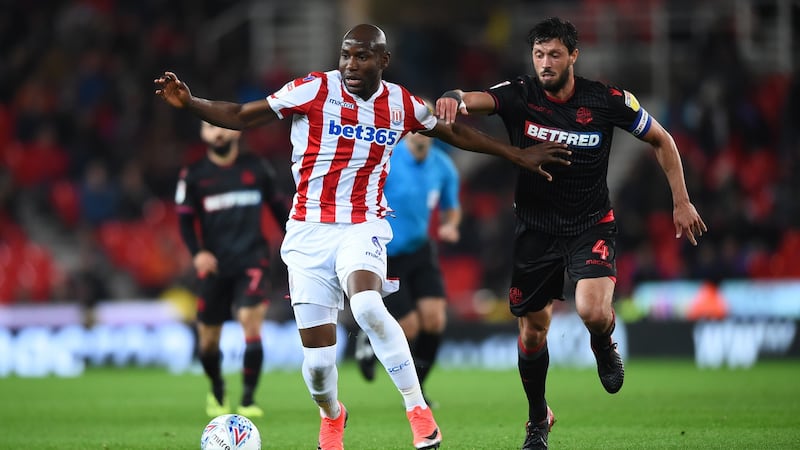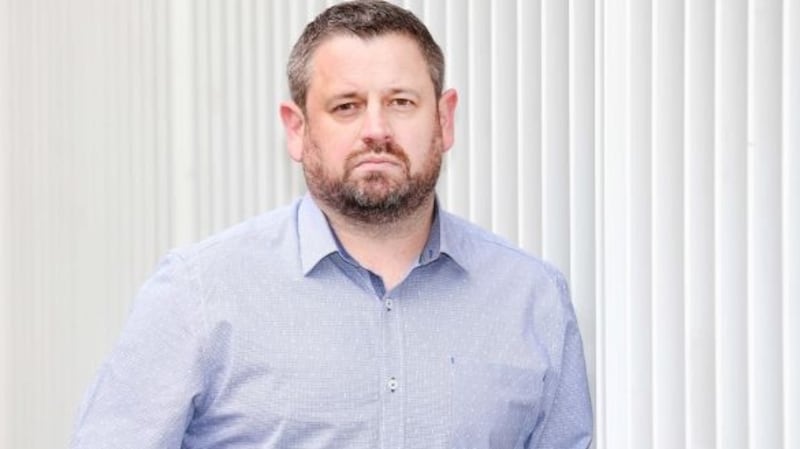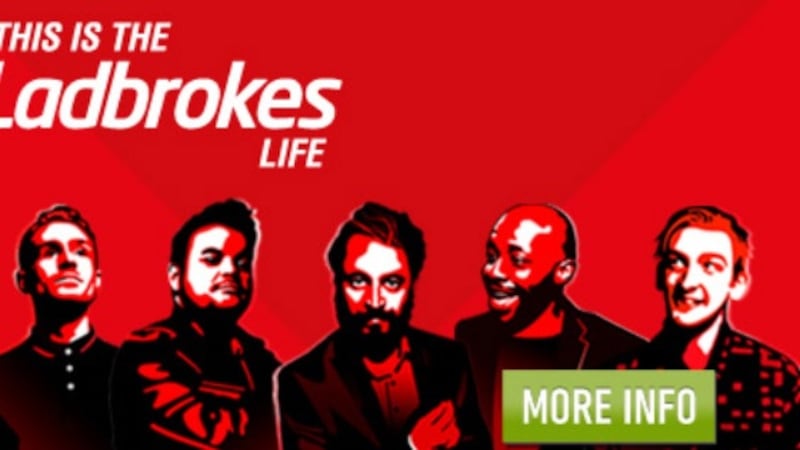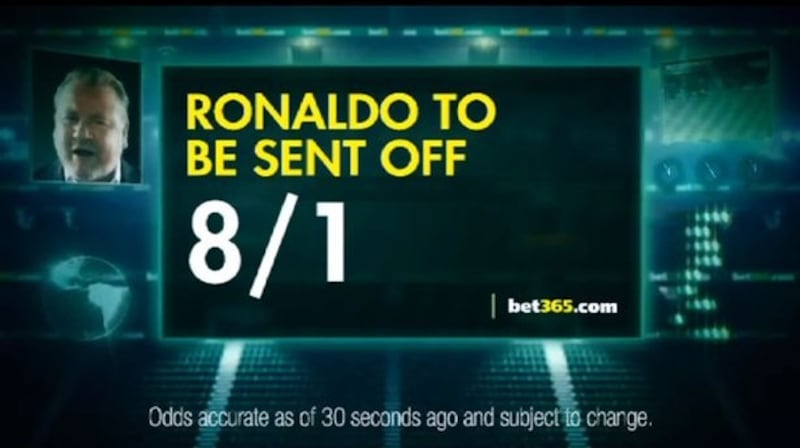Next week’s Championship clash between Stoke City and Middlesbrough is one “for the betting men”. A cash-out clasico that illustrates perfectly how the gambling industry has been allowed to position itself front and centre in modern sport.
Come 5.30pm on Saturday, Stoke will take to the pitch at the Bet365 Stadium wearing jerseys with Bet365 logos on the front. Middlesbrough will showcase the logo of online casino 32Red on the front of theirs.
All 22 players on the pitch will have SkyBet logos on the shoulder of their jerseys. The match will be played in the EFL SkyBet Championship and the electronic hoardings around the pitch will show ads for both Bet365 and Sky Bet. Watch on television and you will see at least two or three ads for betting companies during every single commercial break.
Seems like a lot, doesn’t it?
And that’s only the start. Gambling advertising has become such an intrinsic part of sport that it’s becoming difficult to see the line between the activity itself and the enjoyment of the sporting event.
During the recent World Cup in Russia the Guardian reported that a total of 90 minutes of betting ads – the equivalent to an entire football match – were shown on ITV alone during the tournament, amounting to 17 per cent of all total ad breaks. This was one and a half times more than the amount of ads for alcohol and fast food combined.
A simple experiment carried out recently during a Premier League match on BT Sport counted a minimum of two gambling ads during every ad break (including the sponsorship of the programme itself by Bet365) while every break during the Ryder Cup on Sky Sports (in total close to 35 hours of coverage over three days between 6.30am and 6.30pm) carried at least one gambling advert.
During the Republic of Ireland’s recent Nations League clash with Wales there were five gambling adverts shown at half-time alone.
Controversial
Ray Winstone popping up with live in-play odds at half-time has become normal as he encourages viewers to “'ave a go on that”. Paddy Power’s controversial advertising has now reached a stage where they’re pre-empting the banning of new bets. In their latest ad for new ‘same-game multis’ they say that they will “most likely get banned” in the same way, in their words, “as streaking at a football match is banned” and that it is best to act quickly and take advantage of these great new deals.
James Buckley – more well-known as Jay from The Inbetweeners – has replaced Chris Kamara as the star of Ladbrokes advertising aimed at "the bettors of Britain" while Betfair opt for a slickly dressed thirtysomething-year-old man walking into some sort of bookies of the future with huge interactive screens and lots of other sharply dressed people who have the edge not just on the bookie, but on the other punters themselves via the Betfair exchange.
Contrast that to the reality of a real bookmaker in any small town around Ireland and the power of marketing is clear to see.
Not only does advertising promote the product but interactive ads give punters the opportunity to act and take part in that product immediately after seeing the in-play promotion which has flashed up at half-time or before the game.

Looking at online advertising, the interactive element reaches a new level again. Scroll through any web page (even this one that you may be reading this article on) and, if Google’s algorithms have you down as someone who is interested in gambling, you will be bombarded with pop-up ads for bookies and, in particular, for new account offers and free bets.
This advertising, in particular, can be extremely effective.
If a viewer sees an ad for a beer they like or a car that takes their fancy they still have to go to the shop or the dealer and purchase the item. With pop-up gambling ads it takes just one click to reach the bookies’ website and therefore one click to engage in the product being advertised.
When these ads pop-up for people under the age of 18 or, perhaps, for someone who is recovering from a gambling addiction, significant problems can arise.
Dominant
"Technology has moved us all on and the fastest growing betting product is in-play betting which is heading towards being the dominant form of sports betting – it's already 70 per cent in Spain and getting on to 50 per cent in the UK," says Prof David Forrest of the University of Liverpool management school.
“The role of advertising is now different in that context because now the betting product and the sports product are so intertwined. It’s not incidental that they are advertising odds during the game because the product is the consumer watching the game interactively, responding to events on the field and placing bets. I’d say it’s a joint product, it’s a joint sports and betting product.”
Recently, a BBC investigation found that 15 football clubs – spanning the Premier League, Championship, League One and the Scottish Premiership – had links to online gambling firms on the junior sections of their website.
This is despite the Advertising Standards Authority guidelines saying that gambling cannot be advertised to under-18s – the same regulation which applies in Ireland under the code of ethics of the Advertising Standards Authority of Ireland.
All of these clubs, including Wolves in the Premier League and Celtic in Scotland, had gambling companies as their shirt sponsors. In total, nine of the 20 Premier League clubs carry gambling companies as their shirt sponsors while, in the Championship, it is 17 of the 24 teams.
In Ireland the GAA voted at annual congress last February to ban all sponsorship from gambling companies. In contrast, the FAI’s contract with Trackchamp – on which overseas viewers can access live streams of games as long as they open an account and place a bet – still has two years to run.

"There are a couple of categories in sponsorship which, how will I put it to you, are sometimes controversial," said FAI chief executive John Delaney in August.
“Ultimately for the Association – and this applies to a lot of sporting bodies – when you get that revenue, where does that revenue go? That’s the key to me,” Delaney said.
The idea of gambling and sport as a joint product is one that continually comes up when looking into the issue of advertising. Many believe gambling is now so intrinsic in sport – particularly football – that it has become as much a part of the experience as watching the game itself. For some, the gambling element is of even more importance than the game itself.
All it takes is a trip down to the local pub on a Saturday afternoon to see a group of, generally, young men, all with their phones on the table, watching the 3pm kick-off between Burnley and Huddersfield, or whoever else it might be. The teams involved don’t actually matter that much. Would they be watching that match at all if there wasn’t an opportunity to bet on it? Is it the old SkyBet slogan of “it matters more when there’s money on it,” coming to life?
And what if a few bets are lost in the first half? The account balance is getting low. And then comes along the half-time, in-play odds adverts to tempt you back in. Burnley's Chris Wood to score the next goal at 5/1? It's certainly tempting.
Six-fold rise
Research from Prof Rebecca Cassidy at Goldsmith University in London estimates that gambling ads increased six-fold in the six-year period between 2007 and 2013. Many of these are in-play ads which are the big driver for most of the main gambling firms. Between March 2016 and March 2017 Bet365 generated £2.2 billion (€2.5 billion) with 72 per cent brought in from in-play betting.
“There is perhaps more potential for harm than in the past because we know that vulnerable people might, for example, be very susceptible to a ‘cause to buy now,”’ says Forrest.
“All online companies use this like the ‘last available room’ on a hotel booking site. But in the case of in-play betting, when it says ‘bet now’ on the next goal being scored by United you had better bet now because there could be a goal in the next minute.
“To the ordinary consumer that’s part of the excitement and the consumer requires some way of getting the odds to go along with the game taking place. But one can imagine that the vulnerable are almost being incited to spend when they might be individuals whose spending is at a risk of getting out of control.

“I say to people: ‘Ten years ago who could imagine British television would buy Dutch football games?’ Because where’s the excitement in watching Eindhoven versus Groningen? But of course you can now make that game exciting by seeing yourself as part of it – I think that’s the fundamental change in consumption. They’ve always been related products but now, for some consumers, it’s the same product because it’s their way of taking part in the football game.”
In Ireland the Institute of Public Health says that there are more than 100,000 problem gamblers in the country.
In 2016 gambling losses in this country totalled €2.1 billion which was the third highest rate of gambling losses per capita around the world, according to researchers H2 Gambling Capital. Only Australia and Singapore ranked higher. For those 100,000 problem gamblers the level of advertising can be a problem. For those in recovery, simply sitting down to watch a match must bring about thoughts of gambling and in-play ads could easily tempt someone to relapse.

In some ways it’s akin to a recovering alcoholic spending their leisure time in the pub but in other ways it’s not. For the gambler there are no obvious signs of their addiction and a smart phone provides the privacy and secrecy to bet as much as they want without anyone knowing.
Dangers
Tony O'Reilly is the co-author of the book Tony10 which charts his journey from a €1 bet to a total spend of €10 million, €1.75 million of which was stolen from An Post and the end result of which led to a prison sentence.
He is now a gambling addiction counsellor and works with the company Epic Risk Management to educate people on the dangers of gambling and how to gamble responsibly.
He is clear that he does not have anything against bookmakers and that gambling, for most people, is a perfectly enjoyable and responsible pursuit. However, advertising can still have the potential to trigger old habits for many recovering addicts.
“For me I find I’m at my most vulnerable when it flashes up,” O’Reilly says.
“I don’t use Facebook that much but when I’m on I get these offers popping up because their marketing ploys are obviously geared towards me because my name is synonymous with gambling. So, for me, it’s out there but then I make an informed choice not to bet.
“With technology I was always only a click away from losing the house or losing thousands and you can do it when you’re sitting eating dinner with your family.
“The amount of it on telly during matches would be my main concern. I wouldn’t have a huge issue with the sponsors on shirts as such. I think the ones during half-time in matches – like the Ray Winstone (Bet365) ones – are the ones I’d have a problem with.
“They’re the ones I’d kind of be concerned about because there’s children watching them and it’s very, very much in your face and it’s very engaging. It’s great marketing but, even for me who’s free of gambling for seven years now, when you see the odds flash up on, say, Messi to score next, it sows that seed in your head and then you watch the second half with that in your mind.
"I think it's the timing of it as well – part of what I believe they should bring in as legislation is to have the advertising after the watershed.
“I was blown away when I saw the ads at first showing the live odds. It does bring it to the front of your mind when you’re watching the second half because you’re wondering if the bet will come up.”
This is something that is further backed up by a study carried out by Prof Crystal Fulton of University College Dublin. Playing Social Roulette was compiled to examine the social impact of gambling in Ireland, and to understand the issues from the perspective of those affected. When it came to advertising, participants had a number of issues.
Recovering gamblers spoke of how advertisements included with televised sporting events negatively affected them, because they were trying to recover from addiction while they also connected advertising with triggers for gambling. For instance, seeing the racing page in the newspaper or advertising on television could trigger problem behaviour.

In the study some participants were also critical in their observation that the national broadcaster allows gambling advertisements during sporting events – potentially exposing young people in particular to gambling.
When contacted by The Irish Times with questions about how ads are picked to be shown during RTÉ programmes and whether or not there are limits on the amount of ads for particular industries during programmes, the broadcaster did not respond with details but issued the following statement: "The carriage of gambling advertising is permitted by the BAI's General Commercial Communications Code. RTÉ adheres to these guidelines as well as the Code of Standards for Advertising and Marketing Communications in Ireland from the ASAI."
When asked if there was a limit to the number of gambling ads that could be aired during a programme, the Broadcasting Authority of Ireland (BAI) said that “there is no limit on the volume of gambling related ads (commercial communications) that can be carried on a broadcaster once they comply with relevant codes and rules”.
However, the BAI’s regulations concern only “broadcasting services operating under contract with the BAI or established under Irish statute e.g. RTÉ.” Therefore foreign broadcasters such as Sky and BT do not have to adhere to BAI regulations but rather those set out by Ofcom in the UK which, the BAI says, “provides broadcasting services with greater latitude in terms of gambling advertisements than Irish broadcasting services”.
Ladbrokes Life
Sometimes it seems as if the bookies themselves aren’t even concerned with being subtle about who they target – that market being, largely, young males. ‘The Professor’, ‘The Believer’, ‘Generous John’ and the rest of the motley crew of LADS who starred in the banter-filled Ladbrokes advert which ended with the slogan of “these are the Betting Men. And this, is The Ladbrokes Life,” stands out on that front.
This group of young men who drink beer, watch football and place bets mirror those same groups in pubs around the country watching the football on a Saturday with one eye on the match and one eye on their phones.

Traditionally, TV ads have been an effective medium for marketing but, once the ad is over, it’s up to the viewer to remember it and do something about it. However, if the viewer already has their phone in their hand, they can act on what the ad is offering before it even ends.
Those five gambling ads at half-time in the recent Ireland versus Wales match were all calling on us, the viewers, to gamble. Aside from the fact that betting is, for most people, a perfectly enjoyable and problem-free endeavour, is this level of advertising really necessary? Do we really need to be told when to gamble or can we not just decide of our own volition?
Even if a punter does happen to have an ‘edge’ on the bookies and begin to win big, they can be full sure their stakes will start to be curtailed. Bookies watch winners closely and will take action if a customer wins too much.
On the other hand, if you lose and lose and lose you can expect to continue to keep losing due to the complete lack of regulation in Ireland which, in contrast to the UK, puts no responsibility on the bookies to respond to customers who look to be gambling beyond their means.
Statistics show that almost 75 per cent of adults ‘second screen’ (usually with a phone or tablet) while watching the television. With phone in hand we’re all only a few swipes away from placing that bet.
The gambling industry now has such a strong grip on sport that, if it left, there would be a noticeable void with TV revenue deals in particular – such as the current €5.7 billion Premier League deal – taking a hit. By the time the token “when the fun stops, stop” slogan is hastily thrown in at the end, the bet is as good as placed.
Can sport still be enjoyed simply for what it is?
Or have we reached a stage where the two have become one?
If the slogan is true and it really does matter more when there’s money on it, then that question answers itself.















